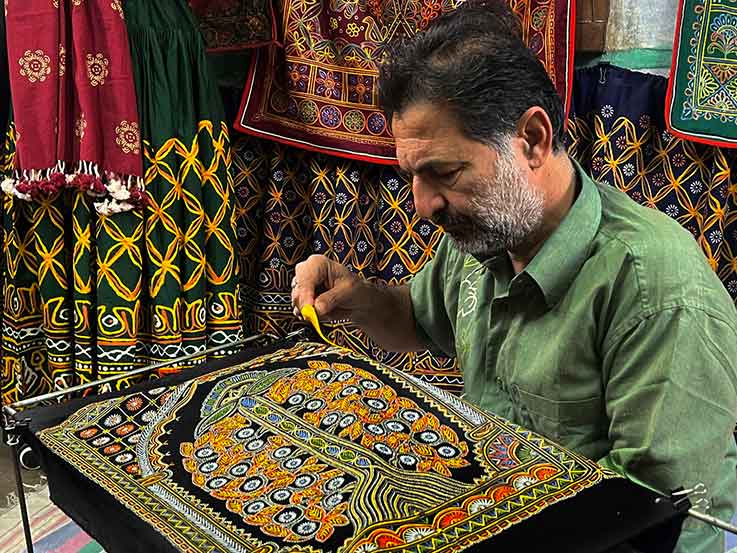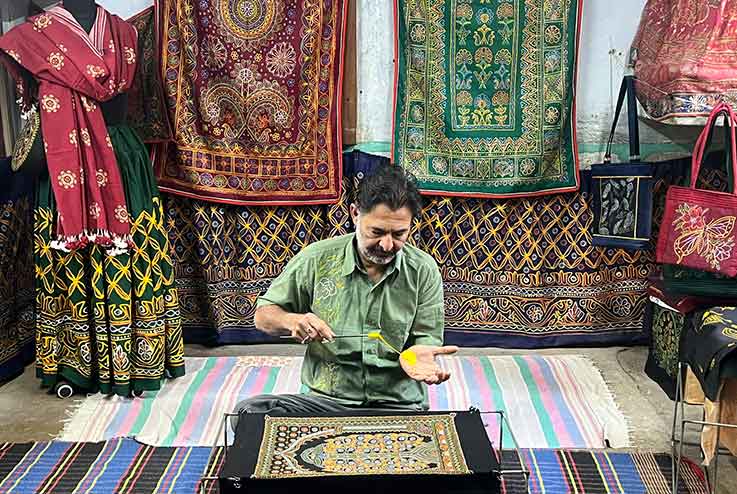More than 1,550 years ago, a captivating art form emerged in India. Over time, it found a home in Madhapar Village, Kutch, becoming a treasure of the region. This extraordinary craft, known as Rogan Art, is preserved today by the Ashish Kansara family—the last custodians of this ancient tradition of Rogan painting.
Its origins, believed to date back to Buddha’s disciples, make Rogan painting a symbol of India’s cultural and artistic resilience.
The Intricacy of Rogan Art

Rogan painting is named after its unique method of creating designs with paint threads, manipulated skillfully onto fabric. Unlike conventional painting, this craft avoids direct contact between brush and canvas. Instead, the artist stretches a thread of paint with one hand while shaping the design beneath the fabric with the other.
This technique produces intricate patterns, showcasing the artisan’s imagination without the use of stencils or pre-drawn sketches. This craft is renowned for its traditional motifs, including the famous Tree of Life and Rogan Art Lehengas. Its abstract and symbolic designs distinguish it from other crafts, with no use of figurative elements. Ashish Kansara also famous for gods painting, like Shree Raja Ram Darbar.
The vibrant colors in handicraft are made from natural extracts combined with castor oil, resulting in rich oil-based paints. Popular shades like blue, green, yellow, and orange are often applied to dark fabrics, enhancing their brilliance.
The Artistic Journey: Creating Rogan Art
The creation of Rogan Art is as magical as its outcome. The process starts with preparing the paint: castor oil is boiled to a specific consistency, then blended with natural pigments to form a malleable paste. This paint is stretched into fine threads and meticulously applied to fabric to create stunning patterns.

This unique process is a testament to the artisans’ dedication, skill, and patience. The intricate designs are entirely handcrafted, preserving the authenticity and charm of the craft.
A traditional verse often recited by artisans beautifully encapsulates their passion:
“In the land of Gujarat,
Be proud of the air you breathe.
Stripped of vegetation with a spectacular desert,
Is the land of Kutch you seek!
Travel back to the vibrant past,
Of artisans and legends,
Who knows no religion nor any caste.
Catch a glimpse of them working,
As their art narrates the rich history,
Of Indian culture, now safeguarded by Kansara of Kutch.”
This poetic connection reflects the pride and deep cultural roots that Rogan craft embodies.
Ashish Kansara: A Guardian of Rogan Art
Ashish Kansara, a modern-day torchbearer of Rogan kala, was born into a family deeply committed to this craft. Raised in Ahmedabad, Gujarat, he learned the techniques of this craft from his grandfather, the esteemed Jamnadas Kansara. Ashish has skillfully blended traditional methods with contemporary aesthetics to appeal to new generations.
He has collaborated with designers to create breathtaking collections showcased at RAKT fashion shows. His remarkable contributions to the art form have earned him numerous accolades, such as: Craftcentres Winner Award (2019), Craftcentres Fashion Week Participant (2021), Vidisha Craft Award for Artists (2021)
Ashish Kansara is also a pioneer in social empowerment. He has trained 21 women in Madhapar Village, challenging societal norms that once excluded women from practicing craft. His efforts have not only preserved the craft but also provided livelihoods for his community.
Preserving the Legacy of Rogan Art by Ashish Kansara
Rogan Art is more than just a craft—it is a living legacy of India’s rich heritage. The Kansara family and artisans like Ashish Kansara are working tirelessly to ensure its survival, despite the challenges of modernization and diminishing artisans.
By supporting Ashish Kansara’s craft, you contribute to preserving a timeless tradition and honoring the creativity, skill, and dedication of its practitioners. Let us celebrate this extraordinary art form and secure its place in the cultural tapestry of future generations.
Pingback: Lacquer Art Nirona Kutch: Timeless Craft of Gujarat